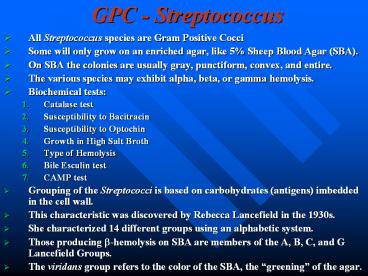GPC Streptococcus - PowerPoint PPT Presentation
1 / 7
Title:
GPC Streptococcus
Description:
Some will only grow on an enriched agar, like 5% Sheep Blood Agar (SBA). On SBA the colonies are usually gray, punctiform, convex, and entire. ... – PowerPoint PPT presentation
Number of Views:383
Avg rating:3.0/5.0
Title: GPC Streptococcus
1
GPC - Streptococcus
- All Streptococcus species are Gram Positive Cocci
- Some will only grow on an enriched agar, like 5
Sheep Blood Agar (SBA). - On SBA the colonies are usually gray, punctiform,
convex, and entire. - The various species may exhibit alpha, beta, or
gamma hemolysis. - Biochemical tests
- Catalase test
- Susceptibility to Bacitracin
- Susceptibility to Optochin
- Growth in High Salt Broth
- Type of Hemolysis
- Bile Esculin test
- CAMP test
- Grouping of the Streptococci is based on
carbohydrates (antigens) imbedded in the cell
wall. - This characteristic was discovered by Rebecca
Lancefield in the 1930s. - She characterized 14 different groups using an
alphabetic system. - Those producing b-hemolysis on SBA are members of
the A, B, C, and G Lancefield Groups. - The viridans group refers to the color of the
SBA, the greening of the agar.
2
Hemolysis
- There are three types of hemolysis on blood agar
plates alpha, beta, and gamma (gamma hemolysis
is actually no hemolysis). - Alpha ( a ) hemolysis produces a greening of the
agar (viridians) that is due to partial digestion
of the red blood cells (RBCs) in the agar. - Beta ( b ) hemolysis produces a clearing of the
agar that is due to the complete digestion of the
red blood cells (RBCs) and hemoglobin in the
agar. - Gamma ( g ) hemolysis produces no change in the
agar. There is actually no hemolysis of the RBCs
in the agar.
The first image shows hemolysis as observed when
the plate is sitting on the lab bench and the
second image shows hemolysis when the plate is
held up to the light.
3
Susceptibility to Bacitracin
- The bacteria tested is considered to be
susceptible (S) to the antibiotic if there is any
zone of inhibition of growth. If a red-ring can
be seen around the disc there is inhibition of
growth. - No red-ring indicates that the bacteria tested
is resistant (R) to the antibiotic. - Record the results for the organism tested as
either (S), for susceptible, or (R) for resistant.
4
Susceptibility to Optochin
- The bacteria tested is considered to be
susceptible (S) to the antibiotic if there is a
zone of inhibition of growth of 15 30 mm in
diameter. - Zones of inhibition of growth of less than 15 mm
are considered to be resistant (R) to the
antibiotic.
5
CAMP Test
- The arrowhead hemolysis pattern is considered
positive ( ) for this test. - No hemolysis or indistinct hemolysis patterns are
considered negative ( - ).
6
Bile Esculin Test
- Bile Esculin agar contains bile which inhibits
the growth of many organisms. - Some organisms can hydrolyze esculin to esculetin
and dextrose. Esculetin will then react with
ferric citrate in the media to produce a
black-brown product. - Blackening of the agar is considered to be a
positive ( ) test. - No change in the color of the agar is considered
to be negative ( - ) for this test.
7
High Salt Test
- Organisms that can tolerate a high salt
environment ( 6.5 NaCl) will grow in broth
causing cloudiness or turbidity. - Turbidity is considered positive ( ) for this
test. - No turbidity (cloudiness) or negligible turbidity
is considered negative ( - ) for this test.































